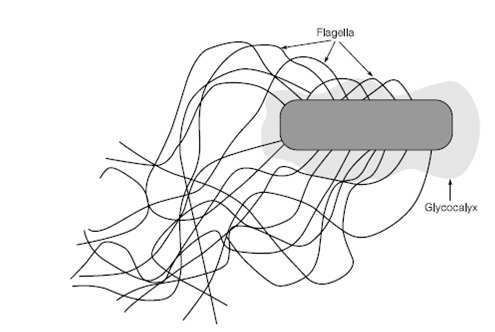External features
All prokaryotes secrete a covering of polysaccharide or polypeptides sometimes known as the slime capsule. The actual composition and size of this glycocalyx vary with the metabolic state of the organism. In several pathogens it is the first line of defense against host recognition. The slime capsule may also help the cell to resist drying out and aid in cell attachment. The interaction of the glycocalyx with other bacteria from the same or different species helps to form biofilms like as plaque on teeth and the bacterial filaments sometimes seen in aquatic environments. A more ordered structure is also present in some Archaea and Bacteria. A crystalline glycoprotein S-layer can form a mesh surrounding the cell and has been linked to attachment biofilm formation and the repulsion of host defenses.
Bacterial motility is often provided through the rotation of flagella long filaments extending outside of the glycocalyx. These are highly complex structures whose composition and role in chemotaxis are discussed further in. After suitable staining, these can often appear to be the dominant feature of cells such as those of Salmonella in Figure 3. Prokaryotes are also coated with other finer hair-like appendages that are generally classed as fimbriae. There are currently seven different types known, identified on the basis of their protein composition, length, and diameter. They are often seen as broken

Figure . The external features of a bacterial cell.
filaments surrounding the cell in electron micrographs suggesting in which they are brittle and dispensable. Some are pathogenicity factors but it is thought that most function in attachment. Finer still are the fibrils that coat the surface of bacteria such as Streptococcus. The limitations of the electron microscope make it difficult to say whether these are a separate type of hairy coat or an artifact from the drying of the glycocalyx. The largest filamentous structures outside the cell are the sex pili generated through F+ bacteria before transduction.